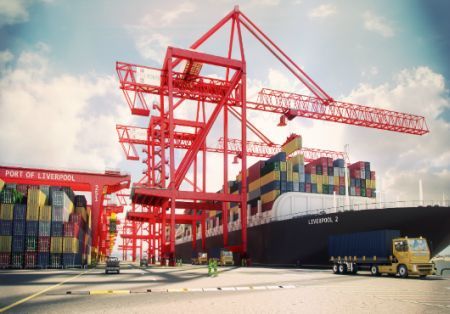
One of the key projects within the Ocean Gateway is the construction of Liverpool2, a £300 million deep water container terminal that will offer companies ship-to-door access to the majority of UK consumers.
With the ability to accommodate 95% of the global container vessel fleet, Liverpool2 will enable the Port of Liverpool to handle two 13,500 TEU post-Panamax vessels simultaneously.
This will create the capacity to handle the next generation of container ships, and will empower the Port of Liverpool to be the UK’s national gateway and transshipment hub for Ireland.
Once completed, the new terminal will enable Peel Ports to improve their current yearly throughput of 65 million tonnes of cargo and 26,000 vessel movements.
World Maritime News spoke to David Huck, Port Director at Peel Ports Group, about the current status of the project, as well as the future impact of the new Liverpool2 terminal on the region of North West England.
WMN: Recently you signed a contract with China’s ZPMC for 8 ship-to-shore megamax quay cranes and 22 cantilever rail-mounted gantry cranes as part of your Liverpool2 project. How far along are you with the project, and what future major plans and investments do you have in store?
Huck: “Liverpool2 is on plan for delivery Q4 2015 and is supported by the key project milestones such as AutoGates (APS) and a new Terminal Operating System (Navis N4) that will be deployed in Q1 2015, and the STaS and CRMG’s that have commenced manufacture.
Other initiatives include 400,000ft of new warehousing in Liverpool, 100,000ft of new warehousing in Manchester, and a new Port Salford, Manchester.”
WMN: How would you assess the overall situation in the UK in terms of the capacity to cater to the needs of ever growing ships?
Huck: “When it opens, Liverpool2 will help round out this connected infrastructure by providing shippers the ability to connect to larger vessels closer to the U.K.’s industrial manufacturing heartland than any other U.K. port, while also offering access to Belfast, Dublin and Glasgow via a short-sea feeder crossing, making the port a central gateway for the U.K. and Ireland.
Liverpool2 will not only double the Port of Liverpool’s container capacity, but it also will connect directly to a number of port-centric logistics hubs along the Manchester Ship Canal and serve as a major transshipment hub to Peel Ports terminals in the Irish Sea in Dublin and Belfast, and Glasgow.”
WMN: How will the Panama Canal expansion, as well as the recently announced Suez Canal expansion affect your operations? Are you going to be ready for the increase in shipping volumes?
Huck: “The Panama Canal and the scope for round the world services will bring Asia and the US East Coast closer to Liverpool. Liverpool2 will be in a position to facilitate the increase in direct and indirect shipments.”
In addition, Liverpool is well positioned to take advantage of the rapid growth of Latin American trade and the £3.5bn expansion of the Panama Canal, scheduled for completion at the end of 2015, allowing it to take much larger vessels and helping Panama establish itself as the logistics hub for Latin America.
When asked about the reasons behind Liverpool Superport Delegation’s visit to Panama in April this year, Huck said that the visit was an opportunity to better understand the market and industry dynamics, and that it was still very much work in progress.
A follow up visit to Panama is planned for autumn 2014 involving a wider trade delegation, supported by UK Trade & Investment and involving further trade partners from the Liverpool City Region and wider North West.
WMN: How important a role will the new Liverpool2 port have in a broader Ocean Gateway project?
Huck: “Liverpool2 essentially adds to the U.K.’s first “green logistics hub” in an effort to reduce those three Cs in cargo owners supply chains: cost, congestion and carbon footprint.
Today, a lot of the imported and manufactured goods in the U.K. enter and exit the U.K. through southeast ports in and around the London area, yet 65 percent of the U.K. and Ireland population is 150 miles from Liverpool.
Peel Ports do not have the infrastructure to handle post-panamax vessels today, but Liverpool2 (a deep water in river container terminal) means that we can address the demand while also working on the value-added aspects our customers’ require, such as warehousing in our central UK corridor.
So the market is here and the port infrastructure will be online towards the end of 2015.”
We use cookies to improve your experience. By continuing to use our site, you accept our Cookies, Privacy Policy,Terms and Conditions. Close X